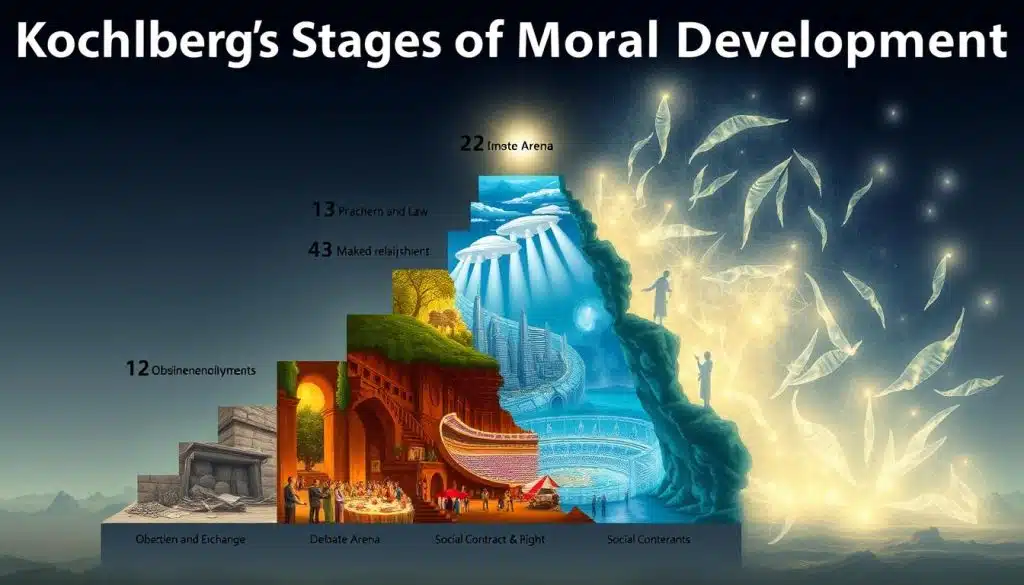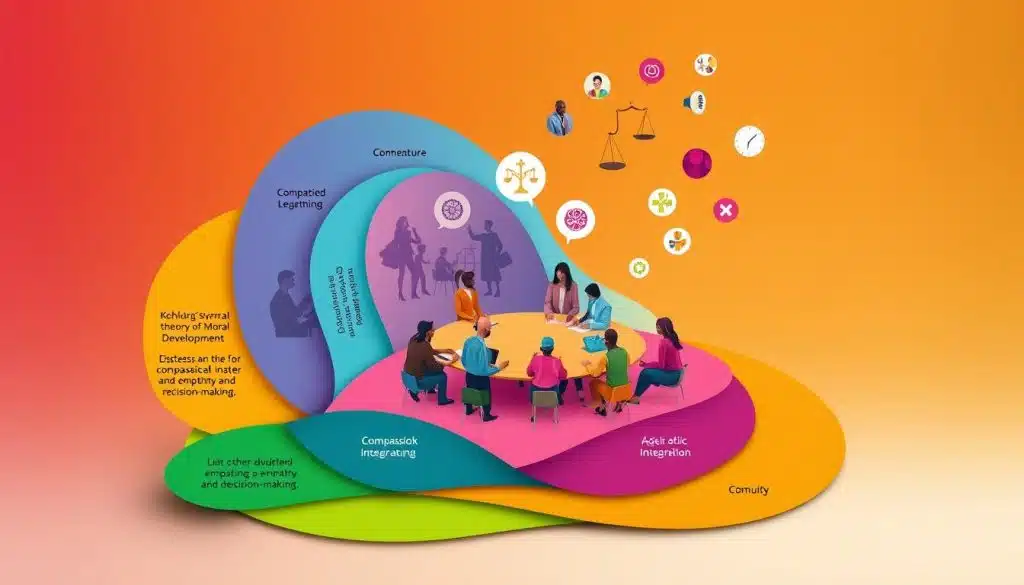Did you know that only 10 to 15% of people ever reach the highest stages of moral development, as outlined by renowned psychologist Lawrence Kohlberg? This theory, developed in the 1950s and 1960s, is a critical framework for understanding the progression of moral reasoning from childhood to adulthood. It’s especially significant for social work practice.
Kohlberg’s groundbreaking research on moral development has deeply influenced the ethical decision-making process and assessment of client behaviors in the social work field. By gaining a comprehensive understanding of this theory, social workers can enhance their professional practice. They can better serve their clients and navigate the complex ethical challenges that often arise in their work.
Moral development is key to personal growth and building strong relationships. It’s especially important in social work. It helps social workers know right from wrong and make ethical choices.
Moral development means growing to understand and use ethical rules in life. In social work, it’s vital for helping clients and making positive changes.
Social workers face tough ethical choices every day. They need to understand moral development to help clients. This lets them connect with clients, plan better interventions, and help them change for the better.
The study of moral development has a long history. Jean Piaget and Lawrence Kohlberg made big contributions. Piaget and Kohlberg helped us see how people grow morally over their lives.
| Theorist | Key Contributions |
|---|---|
| Jean Piaget | Identified two stages of moral development: heteronomous morality and autonomous morality |
| Lawrence Kohlberg | Proposed a six-stage model of moral development across three levels: preconventional, conventional, and postconventional |
Kohlberg’s work has greatly influenced social work. It helps social workers understand and improve clients’ moral choices and behavior.
“Moral development is not just about learning the rules, but about understanding the underlying principles and their application in complex situations.”
At the heart of lawrence kohlberg’s theory of moral development is the idea that moral thinking grows in stages. This theory, based on moral philosophy, shows how people develop morally as they get older. It explains the stages of moral development we go through.
Kohlberg’s stages of moral development theory has three main levels, each with two stages. The Pre-Conventional level is about what happens outside and what we want. The Conventional level is about following what others do. The Post-Conventional level is about understanding what’s right for everyone.
Kohlberg’s theory is tested with moral dilemmas, like the “Heinz Steals the Drug” scenario. This test shows how people think about right and wrong.
“Kohlberg’s theory outlines six stages of moral development that provide insights into children’s reasoning about rights as they progress through each stage.”
Lawrence Kohlbergs theory of moral development says moral development goes through three levels: pre-conventional morality, conventional morality, and post-conventional morality. Each level has two stages. These stages of kohlberg’s theory of moral development show how moral thinking and decision-making get more complex.
The preconventional morality level is seen in kids under 9. At Stage 1, kids focus on obedience and avoiding punishment. They make choices to avoid bad outcomes. Stage 2 is about self-interest. Kids mainly want to get what they want and meet their needs.
According to Kohlberg theory of moral development, as people grow, they reach the conventional morality level. This is common in older kids, teens, and many adults. At Stage 3, people want approval and to fit in. They try to please others and keep social bonds. Stage 4 is about following rules and laws. People see the value in keeping society’s norms.
The highest level is post-conventional morality. This is rare and seen in some adults. At Stage 5, people use abstract thinking. They think about social agreements, rights, and the big picture. Stage 6 is the top. People act based on their own ethics and care for justice and human well-being.
The stages in Kohlberg’s theory of moral development help us understand how moral thinking and decision-making change over time. It shows how important it is to consider where someone is in their moral development. This helps social workers tailor their help to meet each person’s needs.
Kohlberg’s theory of moral development is key for social work. It helps social workers understand their clients’ moral stages. This way, they can tailor their help to meet clients’ needs ethically and developmentally.
According to Kohlberg’s theory of moral development, at the preconventional level, clients make choices based on rewards and punishments. Social workers can use self-interest to guide them. It’s important to reward good behavior and set clear rules.
At the conventional level, clients value following social norms. Social workers can focus on keeping good relationships and fulfilling roles. This helps clients feel they belong.
The postconventional level is the highest stage. Here, clients question and challenge society. Social workers can have deep talks about ethics and change.
Using Lawrence kohlberg theory of moral development is important to social work but it is also a key skill for licensing exams like the ASWB. By applying this theory, social workers can solve ethical problems, help clients grow, and bring about change.

“Moral reasoning guides judgments, emotions, and actions about fairness, justice, rights, and welfare, with moral reasoning helping to recognize when change is needed based on noticing inconsistencies in principles or unequal treatment to others.”
Kohlberg’s theory of moral development has been questioned for its cultural and gender biases. Critics say it might be too focused on Western views and male perspectives. This is because Kohlberg mainly used male subjects in his studies. Psychologist Carol Gilligan pointed out that the theory might not value care and concern for others enough. This is a key part of female moral development.
Gilligan’s critique urged us to think about different cultures and gender views when using Kohlberg’s theory. Studies have found small differences in moral reasoning between men and women. These differences might be due to education and socialization, not gender itself.
Modern views of Kohlberg’s theory try to fix these issues by adding more cultural and gender diversity. Studies across cultures have shown that the first four stages of moral development apply universally. But, they suggest using different content and language for each culture.
In diverse social work settings, Kohlberg’s theory must be used with caution. It’s important to recognize cultural and gender biases. For example, Asian cultures often value harmony more than Western ones. So, adapting the theory to fit these cultural differences is key for effective social work.
| Critique | Finding |
|---|---|
| Western-centric and male-centric bias | Kohlberg’s research primarily utilized male subjects, potentially overlooking diverse cultural and gender perspectives. |
| Overemphasis on justice and lack of care-based moral reasoning | Carol Gilligan’s critique highlighted the need to consider moral reasoning based on care and concern for others, a perspective more commonly associated with female moral development. |
| Differences in moral reasoning between cultures | Research has shown variations in moral dilemma responses between Asian and Western cultures, with Asian societies often emphasizing the maintenance of harmonious social order. |
| Potential for universal applicability | Meta-analyses of cross-cultural studies have provided evidence supporting the universal applicability of Kohlberg’s first four stages of moral development, with adaptations in content and language to match specific cultural contexts. |
“Kohlberg’s theory has faced criticism for potential cultural and gender biases. Critics argue it may be Western-centric and biased towards male perspectives.”
As social workers, we do more than just know Kohlberg’s theory. We must blend this knowledge into our daily work. This helps us better understand our clients’ moral stages, guide their ethical choices, and create specific plans to help them.
Using Kohlberg’s theory with other ideas like Piaget’s and Erikson’s can give us a deeper view. This way, we can look at case studies, spot developmental stages, and suggest plans that take into account moral and broader developmental aspects.
| Developmental Theory | Key Concepts | Application in Clinical Social Work |
|---|---|---|
| Kohlberg’s Moral Development | Stages of moral reasoning, from preconventional to postconventional | Assess client’s moral development stage, guide ethical decision-making, and tailor interventions accordingly |
| Piaget’s Cognitive Development | Stages of intellectual growth, from sensorimotor to formal operational | Understand the client’s cognitive abilities and how they influence moral reasoning |
| Erikson’s Psychosocial Development | Stages of identity formation, from trust vs. mistrust to integrity vs. despair | Recognize the impact of the client’s psychosocial development on their moral decision-making |
| Vygotsky’s Sociocultural Theory | The role of culture and social interactions in cognitive development | Understand how the client’s cultural and social environment shapes their moral reasoning and ethical practices |
By mixing these theories, we get a clearer picture of our clients’ moral and ethical views. This helps us create plans that really meet their needs, leading to better social work.

“Integrating moral development theory with clinical practice allows social workers to navigate the complex ethical landscape and promote positive change in the lives of their clients.”
Good social work needs to understand a person’s moral growth. Kohlberg’s theory helps in this. It guides in assessing a client’s moral thinking and improving their moral maturity.
Figuring out a client’s moral stage involves watching how they handle moral dilemmas. Social workers use Kohlberg’s Heinz Dilemma to see how clients make moral choices.
Knowing a client’s moral stage helps social workers plan better. They might talk about moral issues, use role-playing, or help clients think deeply about their actions.
It’s important to check if interventions work. Social workers can use tests like the Defining Issues Test (DIT) or the Principled Ethics Profile (PEP) test to see if their efforts are paying off.
| Assessment Measure | Description | Key Findings |
|---|---|---|
| Defining Issues Test (DIT) | A widely used instrument to measure moral development based on Kohlberg’s theory. | The median Principled Morality Score was 16.7, with no significant differences observed across cohorts. |
| Principled Ethics Profile (PEP) Test | A profession-specific test designed to measure moral understanding among pharmacy students and practitioners. | The mean increase in Principled Morality Scores observed after a teaching intervention was 8.6. |
By using Kohlberg’s theory, social workers can better understand their clients. They can then create specific plans and track how well these plans work. This helps in improving clients’ moral thinking and decision-making.
Kohlberg’s Theory of Moral Development is still important in social work. It helps us understand moral reasoning and making ethical choices. Even though it has its limits, it’s very useful in social work.
It helps in assessing clients, planning interventions, and practicing ethically. As social work grows, so will the need to update and research Kohlberg’s theory. This will make it even more useful in different settings.
This theory is key for social workers and educators. It helps them grow professionally and improve care for clients. Kohlberg’s theory is essential for maintaining high moral and ethical standards in social work.
By using Kohlberg’s theory, social workers can handle complex ethical issues better. This ensures clients get the best care possible. It also helps keep the social work profession at its highest moral and ethical level.